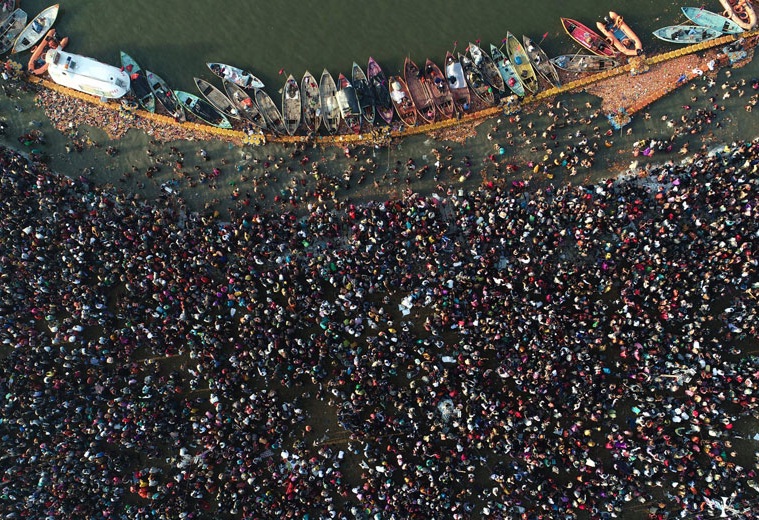Whilst the Yogi Adityanath government 2.0 is working on a blueprint to make Uttar Pradesh a $trillion economy in near future, the state has aces up its sleeve to amplify the economic, tourism and investment bandwidth.
The Yogi dispensation is gearing up to unleash the soft power of ‘Mahakumbh Mela’ to be held in Prayagraj (Allahabad) in the early months of 2025 calendar.
The objective is to pitch the landlocked state on the global tourism map with Mahakumbh, which is considered to be the largest assembly of humanity on Earth.
An estimated 400 million tourists and pilgrims from all over the world are estimated to congregate in Prayagraj during the Prayagraj Mahakumbh 2025.
The civil works on two mega infrastructure projects in UP viz. Jewar International Airport in Greater Noida (Gautam Buddha Nagar district) and Meerut-Prayagraj Ganga Expressway are already in full swing for commissioning by the end of 2024; a few weeks before the Mahakumbh begins.
Earlier, UP chief minister Adityanath asked officials to ensure that the Expressway project was completed before Mahakumbh to facilitate seamless travel to-and-fro Prayagraj during the event.
The government is making extensive preparations for the grandest religious-cultural event by developing and redeveloping tourism sites, temples and ramping up general tourist and civic infrastructure in the holy city.
Devout Hindus consider Prayagraj as one of the holiest cities, which gives salvation if one bathes at the ‘Sangam’, the confluence of Ganga, Yamuna and mythical Saraswati rivers. After coming to power, the Yogi government 1.0 had renamed Allahabad as Prayagraj, thus reverting to its ancient moniker.
Meanwhile, an expansive tent city spread over 3,700 hectares of land would be developed in Prayagraj to accommodate visitors during the several weeks of the Mahakumbh 2025.
Since, the state government is striving to position UP as a global destination for different kinds of tourism including religious, spiritual, historical, medical, wellness etc, the Mahakumbh will come handy to offer a firsthand experience to visitors about the state’s infra facilities, hospitality, safety, cleanliness, tourism friendly policies etc.
In Prayagraj ‘Ardhkumbh Mela’ 2019, an estimated 240 million devotees had arrived in the holy town and nearly Rs 4,200 crore was incurred in its organisation. In contrast, the projected spend in the 2025 edition of the Kumbh is pegged at Rs 6,800 crore, an increase of over 60 percent.
Meanwhile, the UP State Road Transport Corporation (UPSRTC) has planned to discard old and dilapidated buses and replenish the fleet with 5,000 brand new buses ahead of the Mahakumbh.
These buses, equipped with state-of-art passenger amenities, will entail an investment of Rs 2,000 crore. Currently, there are 11,200 buses in the UPSRTC fleet. While 3,500 new buses are likely to join its fleet before March 2024, the remaining trance of 1,500 buses will be procured next year.
“The state is putting great effort into the organisation of ‘Mahakumbh 2025’ in Prayagraj. This includes beautification and redevelopment of temples. About four dozen permanent and temporary civil works will be undertaken in the city,” a government spokesperson said.
The prominent temples, ashrams (monastery) and religious circuits to be redeveloped include Bhardwaj Ashram, Dwadash Madhav Temple, Nagavasuki Temple, Dashashwamedh Temple, Mankameshwar Temple, Alopshankari Temple, Padila Mahadev Temple, Panchkosi Parikrama Path, Koteshwar Mahadev, Kalyani Devi, Shringaverapur Dham etc.
Moreover, the state plans to set up a ‘Digital Kumbh Museum’ at a cost of Rs 60 crore to attract devotees. To be set up by the tourism department, the Museum will showcase the cultural heritage of India and offer insight into the mythological and historical significance of the Kumbh Mela.
Podcast: India’s Annual Budget 2023-24
It will feature galleries with spiritual themes, including Spiritual and Kumbh Mela Interpretation Gallery, Samudra Manthan Gallery and Akhada Gallery. The Museum will comprise a food plaza and shops, allowing visitors to purchase literature and souvenirs related to the Mela.

